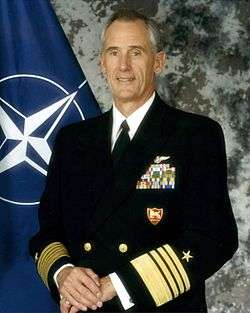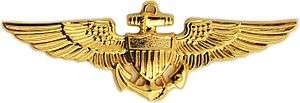Gregory G. Johnson
| Gregory G. Johnson | |
|---|---|
 Admiral Gregory G. Johnson | |
| Nickname(s) | "Grog"[1] |
| Born | 1946 (age 71–72) |
| Allegiance | United States of America |
| Service/ | United States Navy |
| Years of service | 1969-2004 |
| Rank | Admiral |
| Commands held |
|
| Awards | |
Admiral Gregory G. Johnson (born 1946) is a retired United States Navy admiral, and former commander U.S. Naval Forces, Europe and Allied Forces, Southern Europe.
Military career
Admiral Johnson is a native of Westmanland, Maine. He graduated from the University of Maine with a Bachelor of Arts Degree in Political Science. Following Aviation Officer Candidate School, he was commissioned in 1969 and designated a Naval Aviator in 1970.
His initial sea duty assignment was in VA-66 flying the A-7E Corsair II and deploying in USS Nimitz. Subsequent squadron and sea duty assignments include VFA-86 on USS Nimitz; VA-174; Executive Officer and Commanding Officer of VA-105 (Marine Aircraft Group 12, 1st Marine Aircraft Wing); Deputy Commander, Carrier Air Wing Six on USS Forrestal; and Commander, Carrier Air Wing Three on USS Dwight D. Eisenhower.
Shore duty assignments include the Command and Staff Course, Naval War College (graduating with highest distinction); Systems Analysis Division (OP-96) of the Office of the Chief of Naval Operations; F/A-18/A-7 Readiness Officer on the staff Commander Naval Air Force, United States Atlantic Fleet; Joint Chiefs of Staff as Head of the European Command/Central Command Branch of the Joint Operations Division (JOD), Operations Directorate (J-3); and Office of the Chairman of the Joint Chiefs of Staff as the Executive Assistant to the Chairman.
Johnson was selected for flag rank in February 1995. His first flag assignment was as the Director of Operations, Plans, and Policy (N3/N5) on the Commander in Chief, U.S. Atlantic Fleet staff. In February 1996, he reported as Commander, Carrier Group Eight/USS Theodore Roosevelt Battle Group where he served until August 1997. In September 1997 he reported as the Senior Military Assistant to the Deputy Secretary of Defense.
In May 1999, he assumed duties as the Senior Military Assistant to the Secretary of Defense. His previous assignment was Commander, United States Sixth Fleet and Naval Striking and Support Forces Southern Europe. Admiral Johnson assumed duties as Commander, U.S. Naval Forces, Europe and Commander in Chief, Allied Forces Southern Europe on October 24, 2001. He retired from the Navy in December 2004.[1]
Awards and decorations
 | ||
| Naval Aviator Badge | ||
| Defense Distinguished Service Medal with two bronze oak leaf clusters | Defense Superior Service Medal | |
| Legion of Merit with two gold award stars | Defense Meritorious Service Medal | Meritorious Service Medal with two award stars |
| Air Medal with bronze strike/flight numeral 1 | Navy and Marine Corps Commendation Medal | Navy and Marine Corps Achievement Medal |
| Joint Meritorious Unit Award | Navy Unit Commendation with one bronze service star | Navy Meritorious Unit Commendation |
| Navy E Ribbon | Fleet Marine Force Ribbon | Navy Expeditionary Medal |
| National Defense Service Medal with two service stars | Armed Forces Expeditionary Medal | Southwest Asia Service Medal |
| Armed Forces Service Medal | Navy Sea Service Deployment Ribbon with silver service star | NATO Medal for the former Yugoslavia with service star |
| Allied Joint Force Command Naples | ||
- In 2003, he was awarded the Naval War College Distinguished Graduate Leadership Award.
Post military
After retiring from the Navy, Johnson settled in Harpswell, Maine. He started Snow Ridge Associates, a consulting firm. He is also a member of the Energy Security Leadership Council[1] and sits on the board of directors of Integrian, a surveillance technology company.[2] He is also an Outside Director of CACI International.[3]
Johnson serves as a co-leader of the National Security Project (NSP) at the Bipartisan Policy Center.[4]
See also
References
- 1 2 3 Securing America's Future Energy Council Members Archived October 4, 2006, at the Wayback Machine.
- ↑ "Integrian Board of Directors". Integrian.com. Retrieved 2013-08-29.
- ↑ "CACI Management". Caci.com. Retrieved 2013-08-29.
- ↑ "Foreign Policy Project | Bipartisan Policy Center". Bipartisanpolicy.org. Retrieved 2013-08-29.
![]()